RECOMMEND Procedure
Example 1: Recommendations from Explicit Ratings
Details
Problem Description
This example draws on
data that is derived from online movie viewing companies. A company
wants to offer its customers recommendations of movies that they might
like. These recommendations are based on ratings that are provided
by users. The following table contains an example of a user-item-ratings
matrix that online movie viewing companies might use.
|
Customers
|
Movie 1
|
Movie 2
|
Movie 3
|
Movie 4
|
Movie 5
|
|---|---|---|---|---|---|
|
User 1
|
4
|
4
|
4
|
||
|
User 2
|
1
|
1
|
|||
|
User 3
|
5
|
4
|
5
|
4
|
In the sample data,
customers rate the movies that they have seen using a 1–5 scale,
where 1 is the lowest rating and 5 is the highest rating. This table
represents a user-item-ratings matrix. Blank cells correspond to movies
that a customer has not rated.
In practice, the matrix
would be even more sparse than the sample data, as the typical customer
rates only a very small fraction of all available movies. The goal
of the recommender system is to predict ratings for all of the blank
cells. Would User 1 like Movie 4? From the sample above, there is
very little data available. However, with much more data, we might
observe that User 1 and User 3 have similar taste in movies. Therefore,
we could conclude that User 1 would also give Item 4 a high rating,
based on the information that we already have from User 3. In a real-world
situation, it is not necessary to predict every blank entry in a utility
matrix. The system is required to supply only a few suggestions that
a customer would rate highly.
Example Data
This example uses the
MovieLens data set (1M) that was developed by the GroupLens project
at the University of Minnesota. The data that is displayed was downloaded
in February 2014 from the GroupLens website.
Note: Per University of Minnesota
guidelines, you cannot use this data for any commercial or revenue-bearing
purpose without first obtaining permission from a faculty member of
the GroupLens Research Project.
Before invoking the
RECOMMEND procedure, we can print a part of the tables that are included
in the recommender system by invoking the IMSTAT procedure.
proc imstat; table mylasr.movierating; fetch / format to=5; run; table mylasr.movieprofile; fetch / format to=5; run; table mylasr.userprofile; fetch / format to=5; run; quit;
The first FETCH statement
prints a portion of the MovieRating table. The table contains rating
information made by users (customers) about items (movies).
Sample Data from the MovieRatings Table
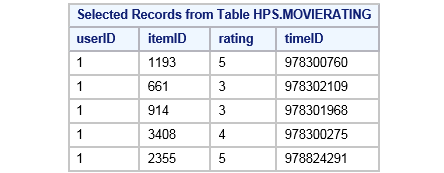
The second and third
FETCH statements print a portion of the MovieProfile and UserProfile
tables. These tables contain information about each movie and user
(customer), respectively.
Sample Profile Data
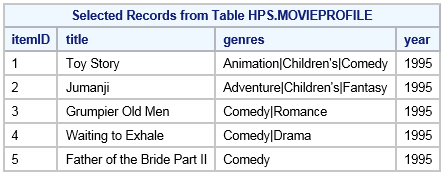
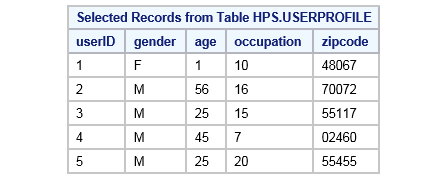
Program
proc recommend port=&portNumber recom = rs.movielens; add rs.movielens /item = itemid user = userid rating = rating; 1 addtable mylasr.movierating / recom = rs.movielens type = rating vars=(itemid userid rating); 2 addtable mylasr.movieprofile / recom = rs.movielens type = item; addtable mylasr.userprofile / recom = rs.movielens type = user; run; method knn / label = "knn" k = 20 positive similarity = pc seed = 1234; 3 run; method slope1 /label = "slope1"; run; method svd / factors = 20 label = "svd" fconv = 1e-3 gconv = 1e-3 maxiter = 100 seed = 1234 MAXFEVAL = 5000 function=L2 lamda = 0.2 technique = lbfgs; run; method ensemble / methods =("svd","knn") label = "ensemble" details MAXFEVAL=5000 maxiter=100 seed=1234 hold=2 withhold=0.1; run; predict / method = knn label="knn" Num = 5 users = ("1","33","478","2035"); 4 run; info; 5 run; remove rs.movielens; 6 run;
Program Description
-
The ADD statement adds a recommender system, MovieLens, to the SAS LASR Analytic Server.
-
Three ADDTABLE statements add the MovieRating, MovieProfile, and UserProfile tables to the recommender system.
-
Each METHOD statement adds a method for computing recommendations to the recommender system. The methods KNN, SLOPE1, SVD, and ENSEMBLE were added with options specified for each method. For more information, see METHOD Statement.
-
The PREDICT statement generates five predictions for each specified user (1, 33, 478, and 2035).
-
The INFO statement requests information about all recommender systems on the SAS LASR Analytic Server. You can also specify a specific recommender system in the INFO statement to filter the results.
-
The REMOVE statement removes a recommender system from the server or removes a method.
METHOD Statement Output
Output from the METHOD Statement Using the ENSEMBLE Option
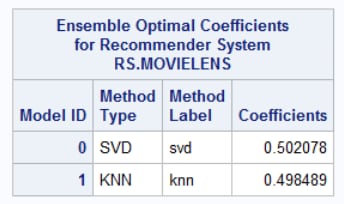
Output from the METHOD Statement Using the Details Option
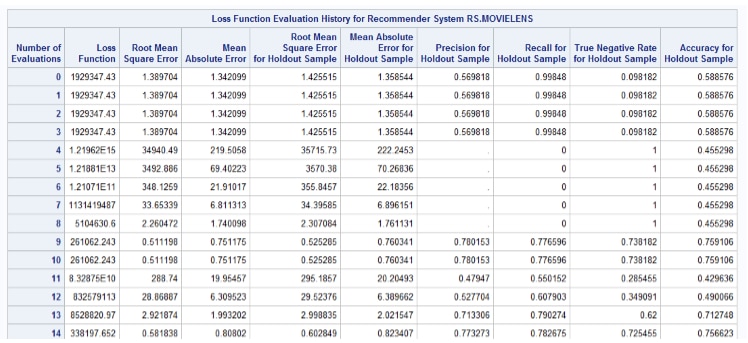
PREDICT Statement Output
Output from the PREDICT Statement
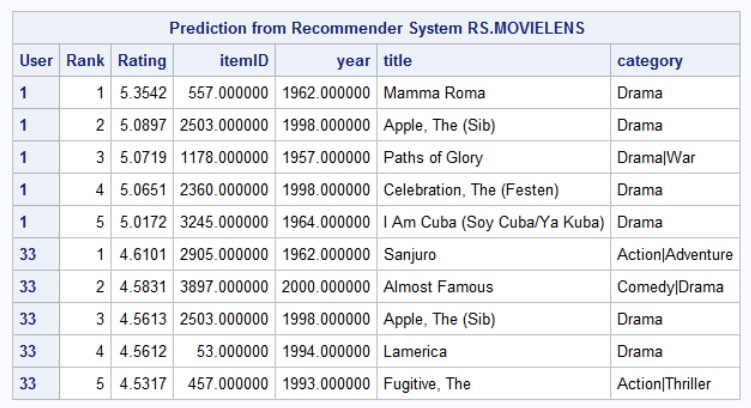
INFO Statement Output
Output from the INFO Statement
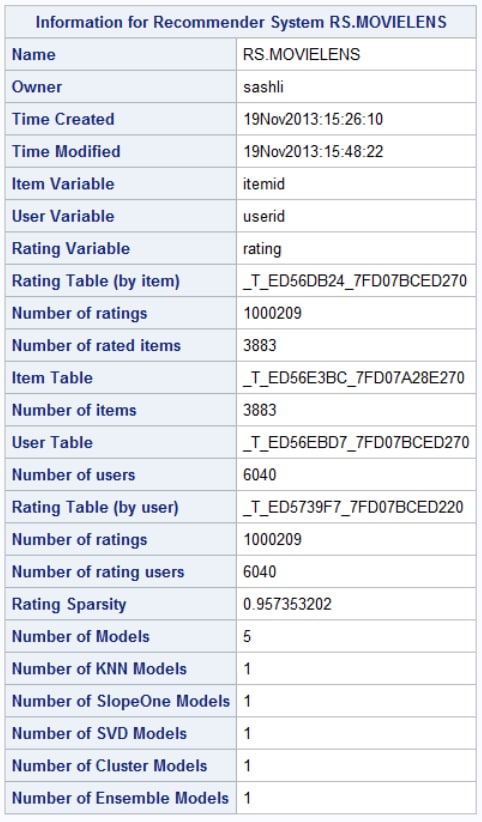
Copyright © SAS Institute Inc. All Rights Reserved.
